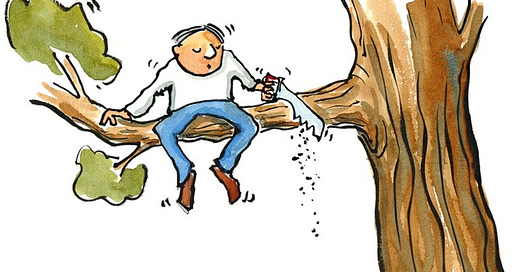Eliminate or Rethink the Department of Canadian Heritage
Post 21 | Bungles, Overlaps and Divisiveness
Over the past month watching the new Argentinian President Javier Milei cut his federal departments by half and lay off 5000 government workers, reminded me of the bloat in our own federal government. How much waste is in the system and how much could we do without? Further, what departments are actually doing us a disservice while eating up resources?
In Post 7, Relentless Government Growth and Reach I challenged readers as to how many of our 42 federal departments they could name or describe, then to further ponder which they felt were unnecessary.
Let’s now examine one of them more closely - Canadian Heritage - a department behind two of the more badly botched pieces of 2023 legislation, a dubious honour among a list of government failures. And a ministry at the nexus of some troubling social issues.
Bill C-18 (Online News Act) attempted to hold Google and Meta ransom for linking to Canadian news – by many analyses, a symbiotic relationship with news producers. After months of posturing, ineptitude and climbdowns the Canadian Heritage department extracted a measly $100M per year from Google for distribution by a to-be-determined mechanism among the myriad Canadian media sources, while driving Meta to exit the Canadian news business altogether. By almost any account, this has left our options for open and unfiltered news worse than before.
Bill C-11 controversially amended the Broadcasting Act with vague new legislation governing what Canadians can publish on the internet while leaving its interpretation and enactment to the quasi-independent CRTC*. The government sold this legislation as a required extension of Canadian content requirements to online streaming services and a means to protect Canadian heritage. Detractors declare it the further long reach of government to control dissemination of information on these broader digital platforms. Few expect it to roll out even-handedly or democratically over the coming years.
Yet to come, one of the department’s primary 2024 objectives is to modernize and reimagine the CBC, an organization in deep trouble fiscally, culturally and objectively, and felt by many to be an overly funded government mouthpiece. Fox in the henhouse or blind leading the blind, seem like apt idioms for this proposed activity.
I will not comment further on these specific issues as they are well covered elsewhere. But they provide an illustrative set up to tackle fundamental questions about the federal department behind them.
What is the Department of Canadian Heritage? What is their mandate? And how well are they serving Canada?
[*The Canadian Radio-television & Telecommunications Commission (CRTC) is designated as an “administrative tribunal” and not a Crown Corporation, but with responsibility to enact the Broadcasting Act, Telecommunications Act and Canada’s Anti-Spam Legislation.]
A brief history
Canadian Heritage was initially formed under the short tenure of Prime Minister Kim Campbell in 1993, then brought into formal being through the 1995 Heritage Act. Its first Minister was Sheila Copps under Jean Chretien’s 1996 government. In 2006, Prime Minister Stephen Harper expanded it to be the Heritage and Status of Women department, then added Official Languages to its portfolio from 2008-13. The department lost its Official Languages title under the Trudeau government while picking up Multiculturalism from 2018-19, before settling back to solely Canadian Heritage. Yet, despite the naming conventions this department has held a surprisingly broad and overlapping portfolio, with considerable impact on the shaping of Canada.
Over the past 28 years there have been eleven ministers with seven Liberals and four Conservatives, eight women and three men, and eight of them from Quebec.
Canadians can be forgiven if they are surprised about our having an entire department dedicated to the heritage of Canada when that very heritage has been beaten down, shamed and rewritten over the past eight years.
During that time our own government has declared us guilty of cultural genocide, stood by complicitly during the muckraking and cancelling of the men who founded and built the country, and advanced an identity-focused environment that has divided us by ethnicity, gender, religion and ideas rather than uniting us in our common Canadian-ness. This from a PM who jauntily proclaimed at the start of his 2015 term that Canada might be the “first post national state” and that “there is no core identity, no mainstream in Canada” – comments that should have enraged Canadians but passed with barely a blink, despite their destructive foreshadowing.
What is the department’s mandate?
Let’s consult four sources to understand the marching orders for the Department of Canadian Heritage.
The 1995 Heritage Act sets out thirteen formal responsibilities as follows in shortened form: promotion of human rights and fundamental freedoms, multiculturalism, the arts, cultural heritage and industries, national battlefields, sport, French language equality, Canadian symbols, broadcasting, foreign cultural policy investment, cultural property conservation, National Capital Commission (NCC) responsibility, and national museums, archives and libraries.
The government website then states that its responsibility, “centres on fostering and promoting Canadian identity and values, cultural development, and heritage” and “the Department is also responsible for administering multiple statutes, including the Canadian Multiculturalism Act, the Broadcasting Act, the Copyright Act, the Official Languages Act (part VII) and the Indigenous Languages Act. In addition, the Department shares responsibility for administering the Physical Activity and Sport Act with the Public Health Agency of Canada.”
The department’s 2021 Mandate Letter from the Prime Minister which sets out its current roles and responsibilities, covers a wider interpretation of duties including significant focus on indigenous promotion and protection, French promotion and protection, various gender and DEI responsibilities, and numerous interventions in the digital broadcasting space, including CBC modernization.
Most confusingly, Canadian Heritage’s 2023-24 Departmental Plan then outlines their “Five Core Responsibilities” as: creative arts and culture; heritage and celebration; sport; diversity and inclusion; and official languages.
But wait just a minute…
We already have six departments covering: Diversity, Equity & Inclusion; Sport; Official Languages; Women, Gender Equality and Youth; Indigenous Services; and Crown-Indigenous Relations.
So, 60% of the core responsibilities of the Canadian Heritage department with 1,850 employees and a budget of nearly $2 Billion (not counting the CBC’s $1.2B), overlap directly with six other departments.
Finally, eleven Crown Corporations report to parliament through Canadian Heritage, where six of them are museums, along with the CBC, and Telefilm Canada, plus the CRTC.
Looked at in sum this department holds a wide and overlapping array of responsibilities and mandates, allowing for generous definitions of what comprise heritage activities.
Helping or hurting our heritage?
In a version of Canada where we felt that our history was being fairly represented, that boasted an independent and functioning broadcasting infrastructure, and where we still held a strong collective pride in our country, a Canadian Heritage department could be a valuable asset.
Sadly, our national cohesiveness is at historic lows evidenced by countless anecdotal markers and supported by various polls including one in June 2022 from Nanos Research where more than 50% of Canadians declared we are on the wrong track regarding national unity.
The vision of Canada advanced by the Trudeau government bears decreasing resemblance to the country many of us know and love. Their divisiveness is partly quarterbacked by the Canadian Heritage department - in charge of promoting the government’s tangled version of our heritage through the selective promotion and subsidization of arts, culture, commemorations and media across an industry they boast to be worth $57B and employing 673,000. That’s a lot of clout to hold in this relatively obscure federal department, with ability to shape the information, tone and tenor in our country and responsible for “fostering and promoting Canadian identity and values.”
Finally, when pondering the idea of national unity promotion consider the following. The Canadian Heritage website formally recognizes a whopping sixty-two (62) Important and Commemorative Days. Depending how you count them, twelve are gender related (women, transgender, and pride - though nothing about men to be found); nearly thirty are celebrating ethnicities including four specific to indigenous commemorations; and at least eight are against or in remembrance/victimhood of something, not counting Remembrance Day. Nineteen of the above have durations of a week or month, and one has a full season (pride).
Yet only five single days appear to celebrate the whole of Canada - notably Canada Day, National Flag Day, Victoria Day, Remembrance Day, and Sir John A. Macdonald Day - with even some of those being under assault in recent years.
The excessiveness of 62 officially listed commemorations (one to start every 5.6 days of the year!) seems a prime example of identity politics gone wild. It promotes an arms race of recognizing and celebrating everything, for need of appeasing voting blocs, ticking boxes, succumbing to lobbying, etc., while simultaneously trying to reduce the potential for grievances. Should I be miffed that I don’t see a Polish or Ukrainian Heritage Month on the list?
I’ll assume everything listed is worthy of recognition and celebration by the groups involved and they should be free to do so.
But in context of a federal department responsible for guiding a country’s national heritage this overdone approach further highlights our individuality rather than our shared values, and dilutes the meaning of those few days in which we can all celebrate together as Canadians based on our similarities instead of our differences.
This all leads me to propose that we do not need a Canadian Heritage Department - leastwise not in its current form. Just as an act of parliament brought it into being, another can similarly disband it and absorb its primary responsibilities into other departments. We thrived 129 years as a country without it and we can do so again.
In absence of dissolution, a new government will need to seriously ponder how to restructure and direct this department to serve Canada.
Regular readers will know that I hold this country dear, remain an unapologetically proud Canadian [see Canada Still Glorious and Free] and believe in the cultural mosaic we learned of in our youth, that is worth celebrating. But we don’t need a government department to further control the information we produce and consume, recraft our heritage, or tell us who we are.
Stay tuned and stay pragmatic.






As always, an Excellent post based on facts that are oblivious to most.
Government Bloat has metastasized into a cancerous growth of Inefficient layers of departments and agencies with duplication and redundancy and inefficiency.
Has this staggering expansion of Bureaucracy improved service or access? A resounding "No"!
Most are increasingly weary of Bloated government and the Burden of excessive Government Payroll on the taxpayer, which has been ever increasing, especially during the past decade of the Trudeau Liberal government.
Additionally, taxpayers are paying for hundreds of thousands of pay raises, hundreds of millions in bonuses and for tens of thousands of extra government bureaucrats who have demonstrated poor performance and inefficiency.
It's time to get Lean!
An excellent post! For sure , this is a department whose mandate few Canadians can describe and whose raison d'etre is so broad and wishy-washy as to be meaningless. Hopefully Javier Milei will be successful in Argentina and "Going Milei" will come to mean, to paraphrase the immortal words of Frank Slade in "Scent of a Woman", taking a flamethrower to bloated government departments.